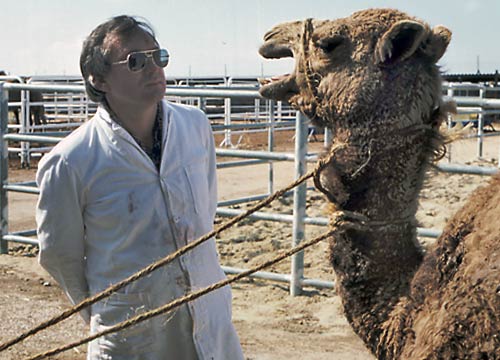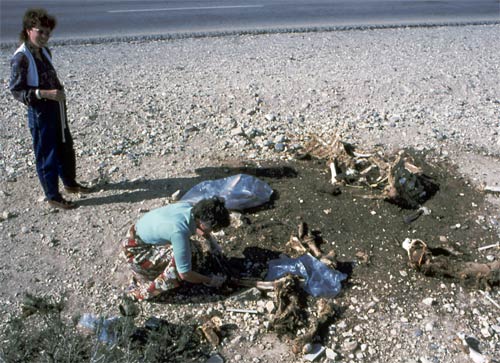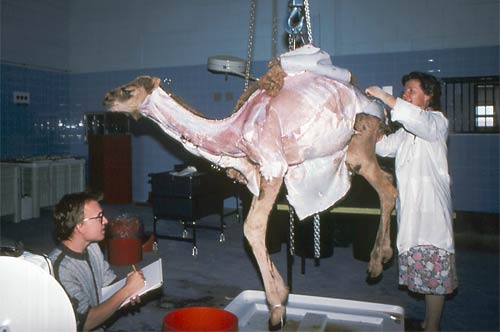|
Why
the camel?...
In
1982, I graduated from the Department of Art
as
Applied to Medicine (now The Division
of Biomedical Communications). My first job
was to travel to Beersheva,
Israel, to work for one and a half
years illustrating the world’s first and
only atlas of anatomy of the camel (the story
of <how> I got the commission is a long
one in itself... buy me a drink and I'll tell
you all about it...).
The
project was organized by the Director of
the Veterinary
Hospital and Isan Center for Comparative
Medicine at Ben Gurion University of the Negev,
Professor
Daniel Cohen. He recruited two anatomists from
the Anatomy Department of the School of Veterinary
Science, University of Pretoria, South Africa...
the remarkable Dr. Malie Smuts and her colleague,
Dr. Braam Bezuidenhout. It was my pleasure
to
work with Malie for the first year, and with
Braam for the remaining six months.
 |
| Braam
looks a gift camel in the mouth. |
My
work began with Malie in August of '82, and the
procurement of specimens to study. Our first
skeletal
material came from 'road kill' and other smelly
bits found in the desert around the northern
Negev
desert, which we had to boil and scrape clean.
 |
| Malie
takes apart some camel jerky while hospital
administrator and chauffeur Sara Sheik looks
on. |
We
were assisted by Shmulik Cohen and Ezat
Abu-Rabiya in
this important (if unpalatable) part of the
project. The dessicated remains were placed in
open top oil drums with water and caustic soda,
then boiled oner an open fire and left to cool
overnight. The next morning, the barrels of
'camel soup' were overturned, and the bones
were removed from the greasy slop. After careful
cleaning and scraping and a few hours under
the hot sun, the bones were ready for study.
Unfortunately, neither skeleton was complete
as they had suffered the depredations of desert
scavengers, and it wasn't until months later
that we had an opportunity to clean an entire
entact camel carcass and obtain a complete
skeleton (and boy, was that fun!).
Just
as the hospital staff were wondering why
a young man from Canada and a doctor from South
Africa had to be brought to Israel (at great
expense, no doubt) just to clean stinky camel
bones, we finally began the task of writing
and illustrating. While Malie and I working
on our descriptions of the skeleton, the
research
centre staff procured a juvenile camel from
the local Bedouin for us to put to sleep
in order to embalm it and dissect the musculature.
We were able to use the hospital's as-yet
unused
large animal surgical theatre as a dissection
hall and a storage area for the large tubs
of formalin which contained the specimens.

next
page..)
Back to Dave
Mazierski Illustration
Page
2>
|